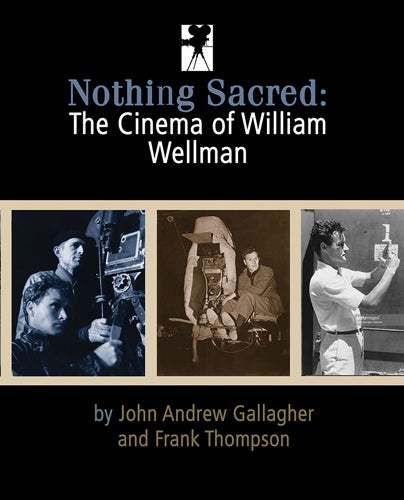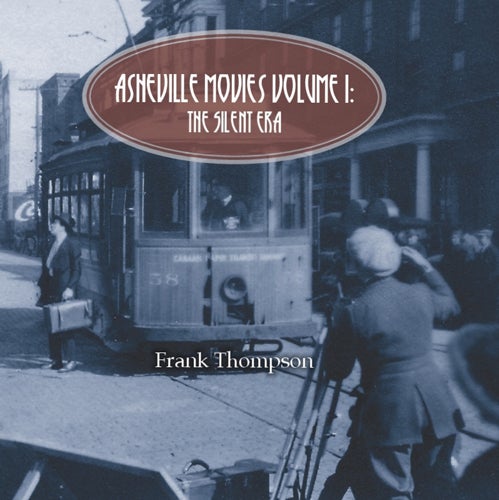If you ask film historians who are some of America’s greatest directors, they may suggest Orson Welles, Frank Capra, John Ford, Martin Scorsese, or Steven Spielberg. Other might put forth names such as Robert Altman, Howard Hawks, William Wyler, or Francis Ford Coppola. Others still may campaign for George Cukor, Billy Wilder, Stanley Kramer, Quentin Tarantino, or Cecil B. DeMille.
However, if you ask noted film historians Frank Thompson and John Andrew Gallagher who they think is America’s single greatest director, they’ll claim someone else all together, William Wellman.
To prove their point, the two have nearly completed a book they’ve been working on for almost 35 years. It’s significant, and it’s massive. And, it’s a work that can rightly be described as the most thoroughly researched, detailed, and richly illustrated book ever published on any director.
Their book, Nothing Sacred: The Cinema Of William Wellman (Men With Wings Press), is an oversized, 700 page, 12" x 9" volume that includes a remarkable 300,000+ words of text and features some 1000 images (many rare) including stills, posters, lobby cards, and ads.

Nothing Sacred: The Cinema Of William Wellman, by John Andrew Gallagher and Frank Thompson
Arguably, Wellman was responsible for three of the greatest films ever made, Wings (1927 – the first film to win the Oscar for Best Picture), The Public Enemy (1931 – the genre defining gangster film), and A Star Is Born (1937 – the single finest film about Hollywood: besides directing, Wellman also wrote its story).
Ever versatile, Wellman worked across genres beginning in the silent era on through to the late 1950s. He made dramas, war films, crime films, comedies, Westerns and adventure stories while working for Fox, Metro-Goldwyn-Mayer, Columbia, Paramount, Selznick-International and others. Many of his most memorable films were made during the Pre-Code era at Warner Bros., with detours to RKO and M-G-M.
Wellman also directed Beggars of Life (1928 – just out on DVD), Night Nurse (1931 – with a riveting Barbara Stanwyck), Nothing Sacred (1937 – the first screwball comedy filmed in color), Beau Geste (1939), Roxie Hart (1942), The Ox-Bow Incident (1943 – an underrated masterpiece), The Story of G.I. Joe (1945), The High and the Mighty (1954) and others. Some of his other under-appreciated movies include The Legion of the Condemned (1928 – now lost), So Big! (1932), Wild Boys of the Road (1933), Lady of Burlesque (1943), Yellow Sky (1948), and Battleground (1949). Each of these films, along with the many others directed by Wellman as well as those in which he had an uncredited hand, are covered in Nothing Sacred: The Cinema of William Wellman.
The writing and production of the book was such a monumental undertaking that it is being published under unusual circumstances. The sale of Nothing Sacred: The Cinema of William Wellman will last for only three months, through December 5, 2017, with the number of books printed depending on the number ordered. The book, a deluxe limited edition printed in full color, will be sent to the printer after December 5, with this edition being the only edition. Each copy costs $150, and each volume will be numbered and signed by both authors.
Thompson explained that the reason the two authors took on this project themselves is that “no publisher on earth would be lunatic enough to allow us to do it precisely as we wanted. And after working on this for more than half our lives, we felt that compromising would be pointless.”
Thompson said the book is as thorough and deeply researched as the most academic text but written, he and Gallagher hope, “with a sense of entertainment and drama. It's illustrated like a coffee table book but the data—such as the exhaustive credits—is equal to any reference book.”
The two film historians met after Thompson had completed his earlier, 1983 study of Wellman. It was Thompson’s first book. Since then, he has gone on to author more than 40 works including Robert Wise: A Bio-Bibliography, Lost Films: Important Movies That Disappeared, Tim Burton's Nightmare Before Christmas, and I Was That Masked Man (written with Clayton Moore, the Lone Ranger). Thompson has also written and directed several documentaries, and worked as a writer and producer in television for 20 years.
Thompson, who long lived in Los Angeles and is now a resident of North Carolina, has recently published another notable book, Asheville Movies Volume 1: The Silent Era (Men With Wings Press). It is a work of local film history, and as such, a fascinating slice of American film history—in that what took place in Asheville was also taking place around the country.

Asheville Movies Volume 1: The Silent Era, by Frank Thompson
John Gallagher is a New York City educator and filmmaker whose credits include The Networker, Blue Moon, The Deli, Sam, The Insurgents, Men Lie, and Street Hunter. He is the also author of Film Directors on Directing, and the forthcoming Hollywood's Forgotten Master: The Life and Times of Tay Garnett.
As they put the finishing touches on Nothing Sacred: The Cinema of William Wellman, both authors are experiencing something of a sense of relief. Thompson said, “This has hovered over both of us for 35 years. There is a sense of accomplishment. Also a certain amount of nervousness. After all, what are we going to do for the next 35 years?”
Thomas Gladysz is the Director of the Louise Brooks Society, a website and online archive launched in 1995. Gladysz contributed an audio commentary to the new Kino Lorber release of Beggars of Life, and recently published a book-length study of the movie, Beggars of Life: A Companion to the 1928 Film. He also had a small hand in the recent restoration of the once lost Louise Brooks’ film, Now We’re in the Air, which screens at Pordenone next month.
